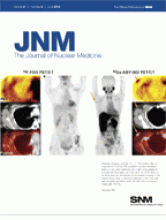REPLY: The purpose of our investigation was to determine a sincalide infusion methodology that has the least variability (lowest coefficient of variation) by comparing 3 methods (15-, 30-, and 60-min infusions of 0.02 μg/kg) and to establish reference values (1). The 3-min infusion method was not investigated because it has previously been shown to have variable and unpredictable results (2,3). This sincalide investigation has the largest number of healthy subjects ever studied and is the first published multicenter study that established sincalide-stimulated gallbladder ejection fraction (GBEF) reference values, and no prior study has compared 3 different infusion methods in the same subjects. The statistical analysis is strong and confirms the significance of our results.
In their letter to the editor the writers state that they use a 10-min cholecystokinin-8 infusion with imaging for 27 min, allowing them to capture gallbladder emptying that occurs after the infusion stops, which they consider important. That may be true for methods with short infusion times. Our 15-min infusion showed minor additional emptying after infusion cessation (Table 1). However, the 30-min infusion showed no additional emptying after the infusion ends. A similar lack of additional emptying after the end of infusion was reported by others for a 45-min infusion method in healthy subjects and patients (4). Therefore, imaging after the end of cholecystokinin-8 infusion may capture additional emptying when short infusion methods are used, but it adds nothing to the longer (≥30 min) infusion methods.
The writers further state that they consider a GBEF value below 50% as abnormal. However, there are no published data to substantiate that claim. It is unclear, then, why these investigators continue to promote short infusions. Although they have published numerous papers claiming that less than 35% is abnormal for a 3-min infusion and less than 50% for a 10-min infusion, they have published no healthy-subject data to substantiate that statement (5–8). The closest they come is in a 2002 publication about a study in which they initially studied 21 healthy subjects (6). However, 8 subjects were excluded because their GBEF was less than 35%, leaving only 13 subjects. The investigators did not claim to have established reference values in that publication.
One might expect the letter writers' method to have results similar to our 15-min infusion. Table 1 of our article provides the mean GBEF and SD for a 15-min infusion, imaged for and quantified at 30, 45, and 60 min. Our data strongly suggest that the authors' conclusion regarding reference values is not correct. From our data, the lower limits of normal for their method would more likely be less than 25% (fifth percentile). In regard to the statistical criticism, we clearly noted that the data were not Gaussian in distribution and that we therefore used percentiles rather than mean and SD to establish reference values.
The writers misinterpret the relationship between abdominal pain and sincalide infusion. No subject we studied had abdominal pain with a 30-min or 60-min infusion, although 2 subjects had symptoms with a 15-min infusion. Prior data have shown that the incidence of pain with a 3-min sincalide infusion approaches 50% (2). Thus, the incidence of abdominal pain in healthy subjects is seen only with short infusion times. In healthy controls and patients with gallbladder disease, Yap et al. found that none had abdominal pain with a 45-min infusion, including those with low GBEFs (4). This is another important reason to use the slow infusion method—the patients will appreciate it.
Referring clinicians have had 2 concerns about the use of sincalide cholescintigraphy to diagnose chronic acalculous gallbladder disease: the first is the lack of sufficient evidence-based data proving the diagnostic utility of the GBEF, and the second is the lack of standardization of the infusion methodology (9,10). We strongly recommend general acceptance of the 60-min infusion method as the standard and that this methodology and these reference values become the standard. We hope that a prospective multicenter investigation will be initiated using this methodology with the expectation that it will confirm the utility of sincalide cholescintigraphy for selecting candidates for cholecystectomy.
Footnotes
-
COPYRIGHT © 2010 by the Society of Nuclear Medicine, Inc.







